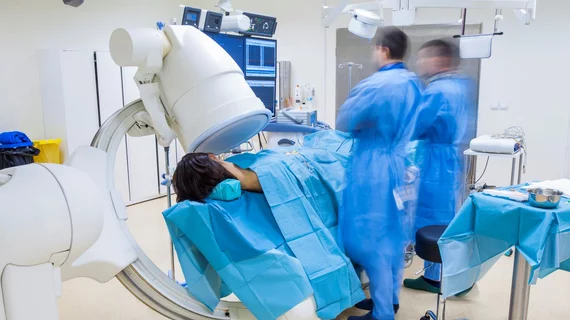The present public-health crisis is affecting all parties involved in medical education. With that as backdrop, three imaging experts have fleshed out the “need-to-knows” for teachers and trainees in their specialty, interventional radiology (IR).
Shantanu Warhadpande, MD, of the University of Pittsburgh; Minhaj Khaja, MD, MBA, of the University of Virginia; and Saher Sabri, MD, of Georgetown University offer their observations in an article posted April 27 in Academic Radiology.
In introducing their key actionable insights, the authors underscore the need to balance appropriate social distancing with essential clinical caregiving.
“Flexibility is paramount in these difficult times,” they write. The burden with which the COVID-19 pandemic is saddling the entire U.S. healthcare system, they add, demands “adjustments in resident and fellow scheduling, re-evaluation of trainee expectations and duties, and an appraisal of the residency graduation requirements.”
Following those areas of activities as an outline, the authors summarize COVID’s impact on IR education at two levels—the early specialization in IR (ESIR) option and the National Resident Matching Program (NRMP), aka “The Match.”
The summaries draw from statements issued by the Accreditation Council for Graduate Medical Education and the Association of Program Directors in Interventional Radiology.
Warhadpande and colleagues lay out five guidelines for current ESIR residents and medical students leaning toward that path during the pandemic:
1. ESIR residents may finish their fifth year post-graduation (PGY-5 year) with fewer than 500 cases—but they’ll need to complete 1,000 cases before the end of their second independent IR residency year.
2. If the ESIR-mandated ICU rotation cannot be completed before graduation, the resident may still graduate with appropriate verification documentation. “If unable to complete during PGY-5 year, discuss with program director at recipient independent IR residency program to facilitate completion during PGY-6 year,” the authors instruct.
3. Working with the relevant clinical competency committee, the IR residency program director may graduate the resident, if deemed competent, even if the candidate doesn’t meet certain case minimums.
4. The exceptions to this point are mammography and nuclear medicine requirements. “These have to be met,” the authors point out, “and residents should work with their programs to ensure the minimum hours/days are completed.” Fortunately for many, telemedicine is an acceptable means of completing these requirements.
5. Low- and high-dose radioiodine (I-131) therapies, a nuke-med treatment for overactive thyroid, may be completed in the PGY-6 year.
For the impact of the public-health crisis on The Match, as well as the authors’ full fleshing-out of changes for ESIR stakeholders, read the paper in its entirety for free.

